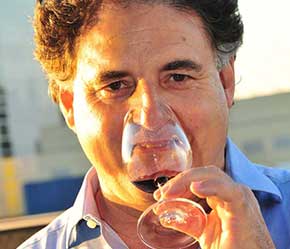 Apparently lightening never strikes twice. In Etna, with Passopiscaro and Terre Nere it has done so in emphatic style.
Apparently lightening never strikes twice. In Etna, with Passopiscaro and Terre Nere it has done so in emphatic style.
After devouring the 2015 & 2016 Cru’s I’m salavating at the thought of ripping the lid of the 2017’s. If the 2017 Rosso, Rosatto and Bianco are anything to go by, we’re in for some fun!
These, Nerello Mascalese, dominant wines with a splash of Nerello Cappuccio exude an entrancing perfume with a delicacy, elegance, and, sophistication that carries through to the palate. With vineyards from 400-1000m in elevation the lower lying vineyards tend to yield bolder styles, while the higher sites offer greater restraint. Texturally the tannins often remind of a more supple Barolo.
Wines of Nerello Mascelese and Nerello Cappuccio have been called the Barolo of the South by some, Italy’s Burgundy by others. I prefer to call them, simply, great wines from Etna.
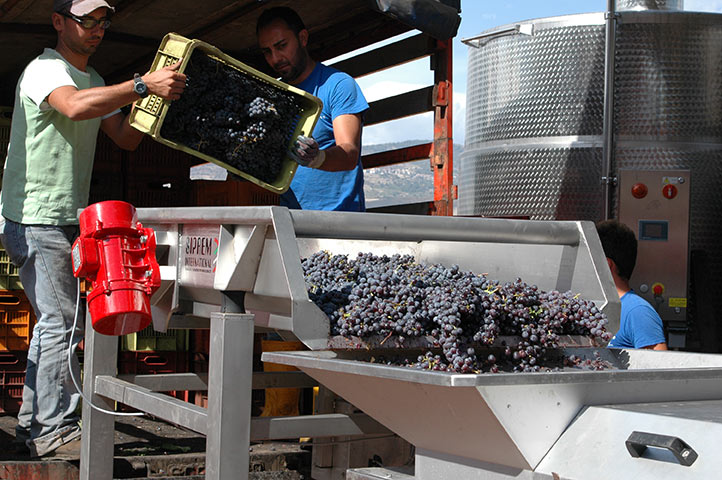
Whilst Nerello Mascelese’s enormous bunches, with there big berries, result in wines of a pale appearance, there is nothing insignificant about their aromas, flavours, and, textures.
Terre Nere’s wines have a balance and purity that goes head to head with and in some cases exceeds Passopisciaro. Put it this way, I was sold on the nose alone of the single vineyards.
All of the elements of success were there from the beginning, exceptional sites from 600m-1000m above sea level on the slopes of Mount Etna, vines of 50-140 years of age, a very clever conductor, ‘Barolo Boy’, Marco de Grazia, the desire to achieve excellence, and, the cash to make it happen.
More recently I tried the Pre-phylloxera wine. To taste wine from 140 year old vines that has not been influenced by growing on a rootstock is becoming a rare thing at a global level. Trying Capellano’s Barolo’s from vine grown on their own roots and American rootstocks, the ‘Pie Franco’ (French foot or rootstock) and ‘Pie Rupestris’ (Rupestris / American rootstock) is perhaps one of the better known opportunities to do so. The difference between the two is striking.
Terre Nere’s Pre-Phylloxera wine has such elegance, delicacy, yet concentration, stunning perfume and spice. The sophistication, line and length of tannin is incredible. Layered and enticing, one to age be I little more patient than I could be with it! Start trying from 2020, will drink for much longer. Heart racing stuff.
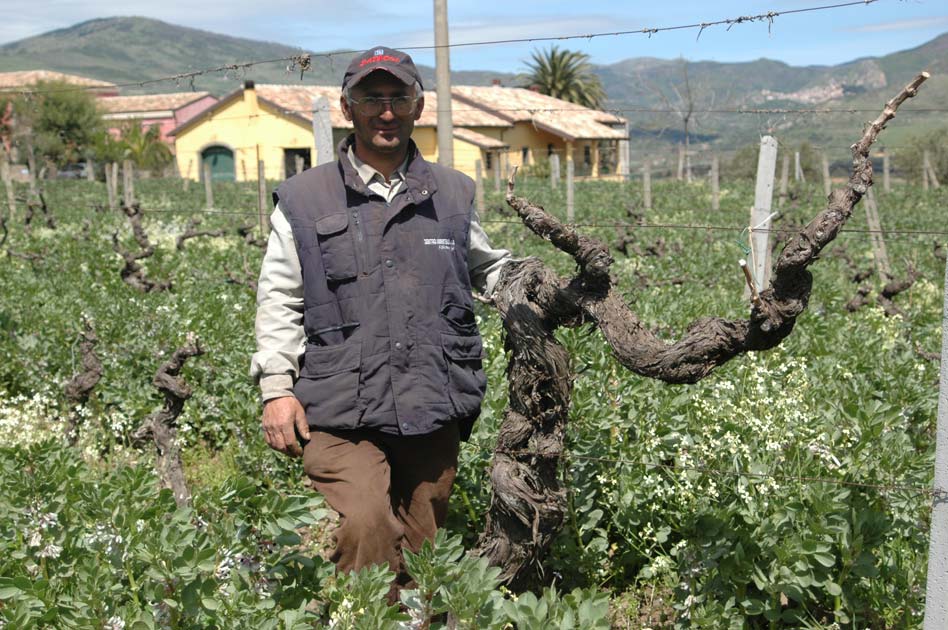
Such vineyards are a labour of love, the incredibly low yields placing them on the knife’s edge of being economically viable. Note the broad beans planted in the vineyard to introduce nitrogen and organic matter through a cycle of composting, helping to build the soil structure.
While you might think vineyard in Sicily would be hot, their elevation combined with planting on cooler North facing slopes can make it challenging to ripen fruit on the highest sites in a cool year.
About Terre Nere
Although de Grazia was one of the architects of the modern style of Barolo, the Terre Nere wines show no signs of those modern, often over-oaked wines, lacking harmony. Poise and restraint being the norm. The larger format oak in the winery, both botte and puncheons are clear sign that sophistication is the intent.
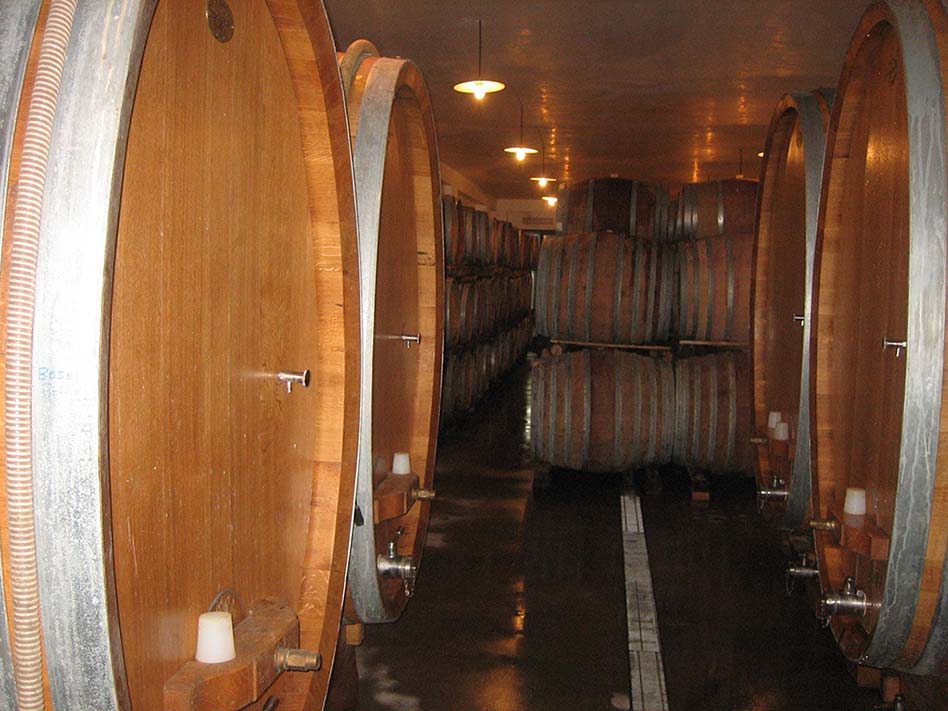
Perfectly articulated by Marco de Grazia himself:
“Tenuta delle Terre Nere is the fruit of over 30 years of passion and work in the world of fine wine.
And an extraordinary location, as well – this “island within an island” that is the Etna – that my brother and I chose. And that, I sometimes believe, actually chose us. A place where nature is prodigal but also severe. And here I try with all my heart to express as purely as possible the refined and multifaceted microcosm of this ancient volcanic land. With respect, care and hard farm work, always in organic balance.
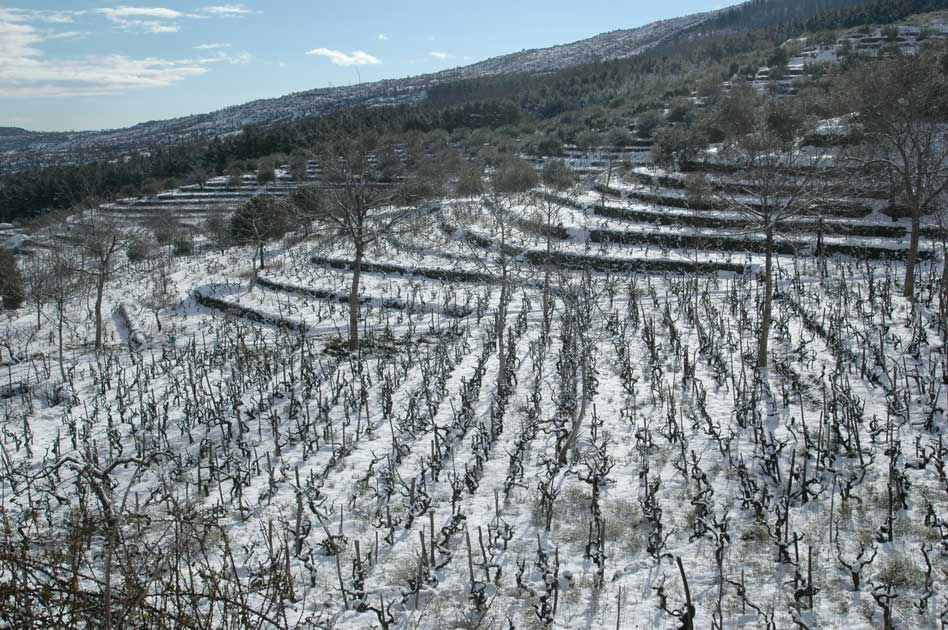
The estate’s philosophy is simple. Given an extreme climate, in order to obtain the best and most consistent ripening, our attention must focus on vineyard management. The finest workmanship in all aspects of viticulture is the first thing that sets us apart. And what enables us, bringing home exceptionally fine grapes, not to be invasive in our cellar work. A work best described as aimed above all at expressing the character of our varieties in their specific terroir.
A great team, a delicate hand and a heightened sensibility, as well. And our ideals, that drive us to give the best of ourselves in quest, not of perfection, but of the ideal bond between what nature gives us and that which our sensitivity, experience and imagination suggests.
All this sets us apart.”
An Exploration of the Vineyards
The 2017 Vintage in Etna
“Sitting down and writing my annual Sicily report has never been so exciting. I don’t remember the last time I tasted through so many world-class wines, both white and red, from Sicily; probably never, in fact. In a nutshell, that’s what you need to know about the state of Sicilian wine today: while the potential for memorable wines has always been there, it appears that at long last many of the island’s estates (though certainly not all) are finally starting to harness that potential.
Due to extreme heat and especially the lack of rain, the 2017 vintage was one of the most difficult in recent memory, although it was not as challenging a year in Sicily as it was in most of Italy. As everywhere else in the country, 2017 was characterized by sustained higher-than-normal temperatures plus an almost extreme lack of rain, contributing to a 20% drop in production all over the island. However, grape varieties behaved very differently. The consensus was that the island’s native grapes fared best, thanks to their centuries-long adaptation to their respective Sicilian terroirs and to the older average age of native vines as opposed to recently planted international varieties.” Ian D’Agata
*All wines are in stock ready for immediate shipment
About the Wines
2017 Terre Nere Etna Bianco
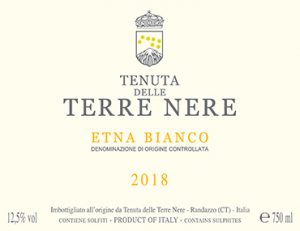 From Marco: I first made this wine in 2005. I wanted to remove that more or less 5% of white grapes that the local vignerons used to mingle with their red ones, in order to make my Etna Rosso from red grapes alone. The white grapes were a mumbo-jumbo of local varieties: Carricante, Catarratto, Grecanico, Inzolia and Minnella. So that’s what my Etna Bianco was: a field blend of all the above, with Carricante dominating the blend with roughly 65%. And that’s what it still is. All from old vines. And, somehow, it works. A perfectly lovely wine. With the effortless uplift of a dancer, it allows me to let it go freely through life, malo included, without it ever losing its bright demeanor and lively step. Deviously drinkable, still it always clings, leaving one wondering how it delights and where do the goodies come from. In aging, the noblesse of the Etna and its remarkable terroir emerge. And the loveliness turns thoughtful and deepens, still graceful, never redundant. Fish, meat or fowl, all are fine, if very gently cooked. It loves seafood, particularly over pasta: after all, it is Sicilian.
From Marco: I first made this wine in 2005. I wanted to remove that more or less 5% of white grapes that the local vignerons used to mingle with their red ones, in order to make my Etna Rosso from red grapes alone. The white grapes were a mumbo-jumbo of local varieties: Carricante, Catarratto, Grecanico, Inzolia and Minnella. So that’s what my Etna Bianco was: a field blend of all the above, with Carricante dominating the blend with roughly 65%. And that’s what it still is. All from old vines. And, somehow, it works. A perfectly lovely wine. With the effortless uplift of a dancer, it allows me to let it go freely through life, malo included, without it ever losing its bright demeanor and lively step. Deviously drinkable, still it always clings, leaving one wondering how it delights and where do the goodies come from. In aging, the noblesse of the Etna and its remarkable terroir emerge. And the loveliness turns thoughtful and deepens, still graceful, never redundant. Fish, meat or fowl, all are fine, if very gently cooked. It loves seafood, particularly over pasta: after all, it is Sicilian.
Area of production: Townships of Castiglione di Sicilia, Randazzo, Biancavilla and Milo.
Varietals: Carricante, Catarratto, Inzolia, Grecanico, Minnella.
Vineyard extension: 13,5 ettari.
Production per hectar: 5-6 Tons
Soil: Volcanic.
Exposure: from many vineyards with differing exposures.
Age of vines: 25-60 years old.
Annual production: 52.000 bottles.
Luminous medium-dark straw yellow. Aromas and flavors of chamomile and balsamic oils along with hints of pear and minerals on the inviting nose. Enters a little subdued, but finishes very strong and long. This builds on you slowly; think of it more like a marathon runner rather than a 100 yards sprinter.
2017 Terre Nere Santo Spirito Etna Bianco
Opposed to my other Etna Bianco, which is a field blend of five varieties, the “Vigne Niche” is 100% Carricante. I made this wine for the first time in 2007, after having had the fortune of tasting a 42 year old Carricante from the East side of the Etna. So beautiful it was, so vigorous and impeccable in its venerable age, that I was moved to produce something like it myself. I tried to imagine how a talented winemaker would have made such a wine half a century ago, with little or no technology. And sought to do the same. The “Vigne Niche” is the result. Then, the 2014 arrived. A truly majestic vintage: if not the best ever, this vintage can be considered for sure one of the best ever on the northern slopes of the Etna.
The stunning quality of the fruit together with older proprietary vines, have now allowed us to expand the range of our production with two new white Crus. In fact, to produce single vineyard Etna Bianco to match the reds is the fulfillment of a dream and of a strategy pursued in a very scientific way. The separate vinifications we do every year have given us all the elements to identify the varietal we wanted, the ideal ripeness, the best land and, in general, the best way of working towards what we’ve had in mind for such a long time.
The two new white Crus, Calderara Sottana and Santo Spirito, feature Carricante grapes from old and young vines, for Carricante is a rare commodity in a D.O.C. overwhelmingly devoted to reds, rarer still on Etna’s Northern slopes. In fact, Carricante vineyards answer for only 4% of the appellation. Both wines are barrel fermented and aged in large oak barrels. These are late blooming wine of unusual complexity and great longevity, which will reward you for your patience with a rare, noble beauty.
Area of production: Contrada Santo Spirito, township of Castiglione di Sicilia (Catania)
Varietals: Carricante
Vineyard extension: 1,5 hectars.
Production per hectar: 6 tons per hectar.
Soil: deep, soft and dark volcanic soil, rich in volcanic ash.
Exposure: northern slope of Mount Etna, from 700 up to 750 meters a.s.l.
Age of vines: 40-100 years old.
Annual production: 6.000 bottles (0,75 lt)
Luminous golden-tinged straw yellow. Minerals and a hint of white flowers on the saline accented nose. Rich round and smooth, with very deep, complex flavors of honey and pomaceous orchard fruit. Finishes long and vibrant, this is absolutely a knockout. 100% Carricante, the vines of which range from 7 to 60 years of age (but De Grazia uses the youngest vines for the entry-level Etna Bianco blend).
2018 Terre Nere Etna Rosato
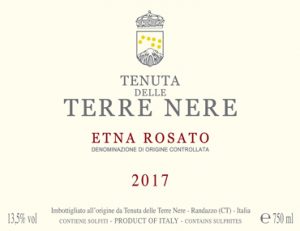 From Marco: I First made this wine in 2007. I love rosé. But I never thought I would make one, just not one of those things that came to mind. But it did come to mind, and powerfully so, to my little Elena: everyone knows how strong the attraction for pink is to the fair sex, particularly at the venerable age of three. Painting the cellar pink just wasn’t enough: a pink wine was to be born. And Nerello Mascalese, wonderfully versatile grape, proved to be just the right stuff. Not an easy wine to make, however. In fact all the opposite. In trying to find balance, you walk a thin line. The Platonic ideal, as I see it, would be the rosé that has the body of a white and the soul of a red, if that makes any sense. Anyway, that’s what I’m looking for: a wine that’s joyful without being frivolous; that has tension, but is not austere. And I feel we come close. Our Etna Rosato is bright and vibrant, but never superficial. The joy it delivers has sophistication. I’ve found out that it ages beautifully. Not that there is any reason to age it. But when it does, the complexity is quite unexpected and remarkable in a rosé. Fish, poultry, soups, pasta, prosciutto and cantaloupe, figs and salame, bread and olives and cheese. You name it.
From Marco: I First made this wine in 2007. I love rosé. But I never thought I would make one, just not one of those things that came to mind. But it did come to mind, and powerfully so, to my little Elena: everyone knows how strong the attraction for pink is to the fair sex, particularly at the venerable age of three. Painting the cellar pink just wasn’t enough: a pink wine was to be born. And Nerello Mascalese, wonderfully versatile grape, proved to be just the right stuff. Not an easy wine to make, however. In fact all the opposite. In trying to find balance, you walk a thin line. The Platonic ideal, as I see it, would be the rosé that has the body of a white and the soul of a red, if that makes any sense. Anyway, that’s what I’m looking for: a wine that’s joyful without being frivolous; that has tension, but is not austere. And I feel we come close. Our Etna Rosato is bright and vibrant, but never superficial. The joy it delivers has sophistication. I’ve found out that it ages beautifully. Not that there is any reason to age it. But when it does, the complexity is quite unexpected and remarkable in a rosé. Fish, poultry, soups, pasta, prosciutto and cantaloupe, figs and salame, bread and olives and cheese. You name it.
Area of production: Townships of Castiglione di Sicilia, Randazzo.
Varietals: Nerello Mascalese and Nerello Cappuccio.
Production per hectar: 5-6 Tons
Soil: Volcanic.
Exposure: from many vineyards with differing exposures, mostly northern.
Age of vines: 25-60 years old.
Annual production: 28.000 bottles.
Ultra pale onion-peel pink. Herbs, almond paste, fresh flowers and cherry skin on the fresh nose. Then bright and juicy in the mouth too, with a subtle gingery bite to the red fruit and herb flavors. Closes long and saline.
2017 Terre Nere Etna Rosso
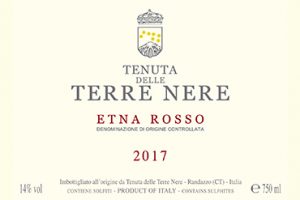 Made from very fine Nerello Mascalese and Nerello Cappuccio from low yielding vineyards (35 Hl. Per hectar), both young and old.
Made from very fine Nerello Mascalese and Nerello Cappuccio from low yielding vineyards (35 Hl. Per hectar), both young and old.
The grapes are macerated until the end of fermentation. The wine then continues its life in wood until bottled roughly one year after harvest. Even young it is a distinguished wine. Fresh, fragrant, beautifully slender and with a fine grip, it has a natural polish, a stage presence, as it were. And, in aging, as its weave gathers into rich complexity, it is a wine for gentlemen. It is an aristocratically liberal wine: enjoy it with whatever food you wish, as long as its properly cooked.
Name: Etna Rosso D.O.C.
Area of production: Townships of Castiglione di Sicilia and Randazzo.
Varietals: Nerello Mascalese (roughly 95%); Nerello Cappuccio (roughly 5%).
Production per hectare: 5 Tons.
Soil: Volcanic.
Exposure: North facing.
Age of vines: 6-50 years old.
Annual production: 120.000 bottles.
A wonderful rendition of Terre Nere. Showing the 2017 vintage to be a little more elegant and restrained.
Drinking Beautifully. More upfront harmony. Expressive. Lovely strawberry earthiness. Excellent perfume. Violets, spice, savoury & bloody. There’s an edge of grip, powdery drying tannin, loads of juicy fruit. Restrained, elegant and sophisticated. Lovely mid-palate weight and persistence. If it’s drinking this well now, I can’t wait to see it in a year or two!
Bright red. Pure nose offers red cherry and raspberry fruit aromas complicated by herbs and minerals. Suave and rather tightly wound, but nicely lifted by salty minerality that accentuates the bright red fruit flavors. Finishes firmly tannic but not drying, with outstanding persistence. Simply a great entry level Etna Rosso.
2017 Terre Nere Santo Spirito Etna Rosso D.O.C.
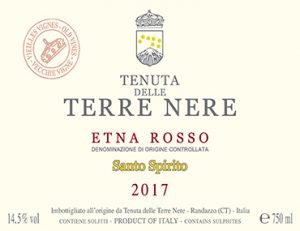 The two vineyards in Santo Spirito are the last ones we bought, the second property acquired in two steps. Santo Spirito is adjacent to Guardiola’s northern boundary and lower in altitude as its slopes descend towards the Alcantara valley. And though adjacent, it couldn’t be more different. An outstandingly beautiful location, gentle wide terraces flowing sweetly in striking contrast to steep, graggy Guardiola. Again, Santo Spirito’s soil is deep rich volcanic ash, its grass a lush emerald green, its vigorous vines displaying a well fed abundance. Santo Spirito’s wines are luscious and sensual, always seductive in their almost fleshy bouquet, and in their buttermilk richness. And yet there’s still a balance and a purity there, very sophisticated, yes, but tender as well. Generous and vulnerable at once. Duke Ellington’s Sophisticated Lady. Creamy soups, Poultry, Pork, red meats. The best? Lovely evening food in lovely evening dress.
The two vineyards in Santo Spirito are the last ones we bought, the second property acquired in two steps. Santo Spirito is adjacent to Guardiola’s northern boundary and lower in altitude as its slopes descend towards the Alcantara valley. And though adjacent, it couldn’t be more different. An outstandingly beautiful location, gentle wide terraces flowing sweetly in striking contrast to steep, graggy Guardiola. Again, Santo Spirito’s soil is deep rich volcanic ash, its grass a lush emerald green, its vigorous vines displaying a well fed abundance. Santo Spirito’s wines are luscious and sensual, always seductive in their almost fleshy bouquet, and in their buttermilk richness. And yet there’s still a balance and a purity there, very sophisticated, yes, but tender as well. Generous and vulnerable at once. Duke Ellington’s Sophisticated Lady. Creamy soups, Poultry, Pork, red meats. The best? Lovely evening food in lovely evening dress.
Name: Santo Spirito Etna Rosso D.O.C.
Area of production: Township of Castiglione di Sicilia.
Varietals: Nerello Mascalese and Nerello Cappuccio.
Vineyard extension: 10 hectares.
Production per hectare: 6 tons per hectare.
Soil: Deep black, rich volcanic ash.
Exposure: Northern.
Age of vines: 40-100 years old.
Annual production: 8.000 bottles.
Luminous deep red. Easygoing red cherry and violet aromas on the fresh nose. Then bright and juicy, with straightforward flavors of red cherry, and minerals lifted by good inner-mouth violet perfume. Closes with a medium-bodied mouthfeel, hints of cranberry and building but polished tannins. Very easygoing and full of early appeal, but this strikes me as a little less complex than past Santo Spirito vintages.
2017 Terre Nere Feudo di Mezzo Etna Rosso D.O.C.
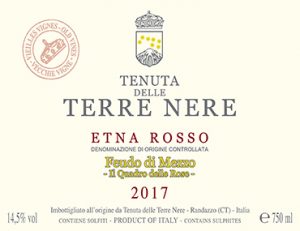 Feudo di Mezzo is the largest cru in the appellation, a homogenous character, but with clear qualitative variations – much like one could say of Clos de Vougeot in Burgundy. From the best parcels – such as our “Quadro delle Rose” – it betrays a dusky character, autumnal tones in its cedary-spicy bouquet. Always the fist to be harvested, Feudo di Mezzo is also always the one readiest to open up and generously deliver itself. Of all crus it is supremely silky, its tannins suave, its bouquet darkly debonair. I love it as it ages effortlessly, its crepuscular nature picking up light as it ripens. Poultry, pork, game, lasagne, braised meats.
Feudo di Mezzo is the largest cru in the appellation, a homogenous character, but with clear qualitative variations – much like one could say of Clos de Vougeot in Burgundy. From the best parcels – such as our “Quadro delle Rose” – it betrays a dusky character, autumnal tones in its cedary-spicy bouquet. Always the fist to be harvested, Feudo di Mezzo is also always the one readiest to open up and generously deliver itself. Of all crus it is supremely silky, its tannins suave, its bouquet darkly debonair. I love it as it ages effortlessly, its crepuscular nature picking up light as it ripens. Poultry, pork, game, lasagne, braised meats.
Name: Etna Rosso D.O.C.
Area of production: Township of Castiglione di Sicilia.
Varietals: Nerello Mascalese and Nerello Cappuccio.
Vineyard extension: 1,5 hectares.
Production per hectare: Less than 5 Tons.
Soil: Black volcanic ash, basaltic pebbles.
Exposure: Northern.
Age of vines: 50-80 years old.
Annual production: 7.500 bottles.
Deep red. Ripe red cherry and raspberry aromas are complicated by musk and earth tones. Then rich, ripe and increasingly tannic in the mouth, with a mouthcoating quality on the long but slightly drying finish. Showcases the rich, forward personality of Quadro delle Rose wines in most vintages, but this seems to have slightly tougher tannins than most I remember at a similar stage of development. Closes long and clean. Try cellaring this to allow the tannins to smoothen a bit.
2017 Terre Nere Moganazzi Rosso D.O.C.
The first time I’ve seen this vineyard. I believe it has been transferred from a tiny project Marco initiated under his daughter’s name, Azienda Agricola Vigne di Eli. Will be fascinating to learn more about it myself!
Zone:Moganazzi District – Volta Sciara, commune of Castiglione di Sicilia (province of Catania)
Vineyard extension (hectares):0.70
Blend:98% Nerello Mascalese 2% Nerello Cappuccio
Vineyard age (year of planting):Nerello Cappuccio 1950 Nerello Mascalese 1950
Soil Type:Volcanic (volcanic ash with black pumice and volcanic rock)
Exposure:Northern slope of Mount Etna
Altitude:650 meters above sea level
Colour:intense and bright ruby red
Nose:Typical, red fruit, mineral notes
Flavour:Full in the mouth, similar to Burgundy wines, elegant, fresh
Serving temperature (°C):18-20
Match with:Meat dishes, seasoned cheese
Average no. bottles/year:1,800
Bright red-ruby. Clean, very mineral and floral, with juicy red/black cherry aromas and flavors. A refined, mineral wine that is very well balanced and precise. This clocks in at 14.5% alcohol, but doesn’t taste warm at all. In fact, I like this wine’s austere, mineral-tinged, long finish. Will likely improve in the bottle.
The Grand Cru's
2017 Terre Nere San Lorenzo Etna Rosso D.O.C.
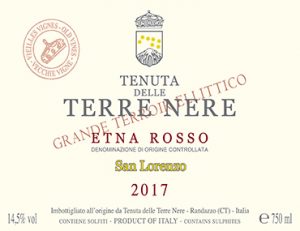 The Etna Rosso San Lorenzo is from 4 hectares of vineyards in the same named district in the town of Randazzo. The vines are more than 70 years and the altitude is 750 meters above sea level, the soil is almost pure volcanic sand. The estimated production is about 60 hl. The terroir in contrada San Lorenzo is originated by lava flows and volcanoclastic deposits related to the effusive and explosive activity of the the Ellittico eruptive center, which dates back from 60,000 to 15,000 years ago. Although very young by geological standards, the soils from the Ellittico eruption are the oldest superficial strata in which one may plant. The reason is simple: millennia of lava flows have buried all older soils, leaving, in fact, only very small and rare parcels of Ellittico soils. On the northern slopes of Etna there are four or five Contrade that have terroir from the Ellittico. Three, however, have mixed soils, blending soil from Ellittico of igneous nature with alluvial soils of sedimentary nature due to the overflowing of the Alcantara river. Only two Contrade out of hundreds and hundreds are “pure” terroir Ellittico: Calderara and San Lorenzo. I wanted to mention this on their labels, so as to facilitate a distinction. The wine from this cru is particularly rich, fruity and has very soft tannins, making it velvety and voluptuous on the palate.
The Etna Rosso San Lorenzo is from 4 hectares of vineyards in the same named district in the town of Randazzo. The vines are more than 70 years and the altitude is 750 meters above sea level, the soil is almost pure volcanic sand. The estimated production is about 60 hl. The terroir in contrada San Lorenzo is originated by lava flows and volcanoclastic deposits related to the effusive and explosive activity of the the Ellittico eruptive center, which dates back from 60,000 to 15,000 years ago. Although very young by geological standards, the soils from the Ellittico eruption are the oldest superficial strata in which one may plant. The reason is simple: millennia of lava flows have buried all older soils, leaving, in fact, only very small and rare parcels of Ellittico soils. On the northern slopes of Etna there are four or five Contrade that have terroir from the Ellittico. Three, however, have mixed soils, blending soil from Ellittico of igneous nature with alluvial soils of sedimentary nature due to the overflowing of the Alcantara river. Only two Contrade out of hundreds and hundreds are “pure” terroir Ellittico: Calderara and San Lorenzo. I wanted to mention this on their labels, so as to facilitate a distinction. The wine from this cru is particularly rich, fruity and has very soft tannins, making it velvety and voluptuous on the palate.
Name: San Lorenzo Etna Rosso D.O.C.
Area of production: contrada San Lorenzo, township of Randazzo (Catania)
Varietals: Nerello Mascalese and Nerello Cappuccio.
Vineyard extension: 4 hectars.
Production per hectar: 5 tons per hectar.
Soil: volcanic, the soil is quite deep and with a small presence of stones
Exposure: Northern slope of the Mount Etna, 700-750 meters a.s.l.
Age of vines: 50-100 years old.
Annual production: 1.700 bottles.
Vivid deep red. Perfumed sweet spice nuances complicate ripe red cherry and strawberry nectar aromas and flavors. Big, dense and juicy, with mounting tannins providing support to the ripe red fruit flavors. Very ripe and downright luscious, with a fruit-forward personality that will make this a crowd pleaser.
2017 Terre Nere Calderara Sottana Etna Rosso D.O.C.
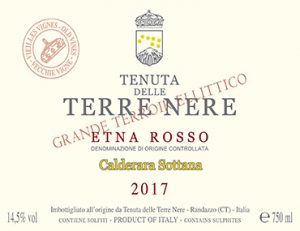 Calderara Sottana’s soil is easily recognizable at first sight. Of all the crus of the Etna appellation it is by far the stoniest. So much so, that in the most remarkable examples you cannot see the soil for the stones: fist sized, light weight, black volcanic pumice. The word Calderara is reminiscent of “caldera” or “cauldron”, probably due to the fact that the black rocks hold the day’s heat through part of the night. The terroir in contrada Calderara is originated by lava flows and volcanoclastic deposits related to the effusive and explosive activity of the the Ellittico eruptive center, which dates back from 60,000 to 15,000 years ago. Although very young by geological standards, the soils from the Ellittico eruption are the oldest superficial strata in which one may plant. The reason is simple: millennia of lava flows have buried all older soils, leaving, in fact, only very small and rare parcels of Ellittico soils. On the northern slopes of Etna there are four or five Contrade that have terroir from the Ellittico. Three, however, have mixed soils, blending soil from Ellittico of igneous nature with alluvial soils of sedimentary nature due to the overflowing of the Alcantara river. Only two Contrade out of hundreds and hundreds are “pure” terroir Ellittico: Calderara and San Lorenzo. I wanted to mention this on their labels, so as to facilitate a distinction. The elevation is 600-700 metres. Harvest is sometime in the second to third week of October. Locally the cru has an outstanding reputation. Our Calderara Sottana is a single vineyard wine produced only from vineyards between 50-100 years old. Of all our single vineyard wines it is perhaps the most complete: much like a wide angle lens encompasses the most ample panorama, so Calderara seems to contain and display the widest spectrum of flavors, bouquets, nuances. Floral and spicy, leathery and aromatic, it delivers a wonderful filling sensation on the palate, yet stepping lightly. Don Peppino, whose devotion to Calderara led him to work our vineyards for seventy years, best describes the wines of Calderara: they are “creamy”, he says. And he’s right. Poultry, red meats, game, pasta, pecorino and bread.
Calderara Sottana’s soil is easily recognizable at first sight. Of all the crus of the Etna appellation it is by far the stoniest. So much so, that in the most remarkable examples you cannot see the soil for the stones: fist sized, light weight, black volcanic pumice. The word Calderara is reminiscent of “caldera” or “cauldron”, probably due to the fact that the black rocks hold the day’s heat through part of the night. The terroir in contrada Calderara is originated by lava flows and volcanoclastic deposits related to the effusive and explosive activity of the the Ellittico eruptive center, which dates back from 60,000 to 15,000 years ago. Although very young by geological standards, the soils from the Ellittico eruption are the oldest superficial strata in which one may plant. The reason is simple: millennia of lava flows have buried all older soils, leaving, in fact, only very small and rare parcels of Ellittico soils. On the northern slopes of Etna there are four or five Contrade that have terroir from the Ellittico. Three, however, have mixed soils, blending soil from Ellittico of igneous nature with alluvial soils of sedimentary nature due to the overflowing of the Alcantara river. Only two Contrade out of hundreds and hundreds are “pure” terroir Ellittico: Calderara and San Lorenzo. I wanted to mention this on their labels, so as to facilitate a distinction. The elevation is 600-700 metres. Harvest is sometime in the second to third week of October. Locally the cru has an outstanding reputation. Our Calderara Sottana is a single vineyard wine produced only from vineyards between 50-100 years old. Of all our single vineyard wines it is perhaps the most complete: much like a wide angle lens encompasses the most ample panorama, so Calderara seems to contain and display the widest spectrum of flavors, bouquets, nuances. Floral and spicy, leathery and aromatic, it delivers a wonderful filling sensation on the palate, yet stepping lightly. Don Peppino, whose devotion to Calderara led him to work our vineyards for seventy years, best describes the wines of Calderara: they are “creamy”, he says. And he’s right. Poultry, red meats, game, pasta, pecorino and bread.
Name: Etna Rosso D.O.C.
Area of production: Townships of Randazzo.
Varietals: Nerello Mascalese and Nerello Cappuccio.
Vineyard extension: 13,5 hectares.
Production per hectare: Less than 5 Tons
Soil: Black volcanic pumice, some ash.
Exposure: Northern.
Age of vines: 50-100 years old.
Annual production: 16.000 bottles
Bright deep red. Flinty floral nuances complement red cherry and herbal notes on the enticing nose. Bright, juicy and round on entry, then showcases a stiff tannic spine and building alcohol-derived warmth with red cherry nectar and smoky flavors lingering nicely. Repeating, vibrant red cherry and sweet spice notes add complexity on the close. Currently lacks a little balance: I would have scored this higher if it didn’t taste so hot (the bottle’s label declares 14.5% alcohol).
2017 Terre Nere Prephylloxera Etna Rosso D.O.C. The vineyard of Don Peppino
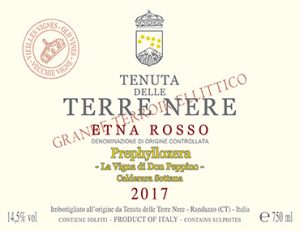 In front and to the right of our cellar in Calderara Sottana there are two parcels, in the midst of a larger vineyard that have survived phylloxera. They, therefore, are over 130 years old and stand on their original rootstock. In 2006 I decided to vinify the grapes from those parcels separately. 2006 was a splendid vintage, rather on the monumental side. These parcels yielded a wine of such unearthly finesse that, although the wine from the neighboring old vines was a real beauty, the Prephylloxera, displaying a very similar character, seemed to feed from heavenly pastures: the quintessence of Calderara. It is a bit shier and will need more time than its younger sibling. I rarely advice decanting a wine, but in this case I do. Its elegance is measured, its authority understated, its sophistication effortless. A grand wine. I suggest many savoury fine courses in very moderate quantities. Allow the wine to grow as the dinner does.
In front and to the right of our cellar in Calderara Sottana there are two parcels, in the midst of a larger vineyard that have survived phylloxera. They, therefore, are over 130 years old and stand on their original rootstock. In 2006 I decided to vinify the grapes from those parcels separately. 2006 was a splendid vintage, rather on the monumental side. These parcels yielded a wine of such unearthly finesse that, although the wine from the neighboring old vines was a real beauty, the Prephylloxera, displaying a very similar character, seemed to feed from heavenly pastures: the quintessence of Calderara. It is a bit shier and will need more time than its younger sibling. I rarely advice decanting a wine, but in this case I do. Its elegance is measured, its authority understated, its sophistication effortless. A grand wine. I suggest many savoury fine courses in very moderate quantities. Allow the wine to grow as the dinner does.
Name: Etna Rosso D.O.C.
Area of production: Township of Randazzo.
Varietals: Nerello Mascalese and Nerello Cappuccio.
Vineyard extension: 0,80 hectares.
Production per hectare: 4-5 tons per hectare.
Soil: Black volcanic pumice, some ash.
Exposure: Northern.
Age of vines: 130 a 140 anni.
Annual production: 5.000 bottles.
Bright red. Pungent flinty and floral nuances to the red cherry and raspberry jam aromas on the inviting nose. Enters rich, dense and almost sweet, with very precise sweet spice and red fruit flavors lingering nicely. An underlying green note remains in the background and adds complexity. Finishes with noteworthy but balanced tannic bite and plenty of freshness on the long juicy finish. A very complex wine with a beautiful nose; the tannins though are on the tough side as in many of these Terre Nere 2017 reds. A very good wine of noteworthy promise, my suggestion is to cellar this for another 4-6 years for full enjoyment.

Place Your Order
Going toe to toe with Passopisciaro!
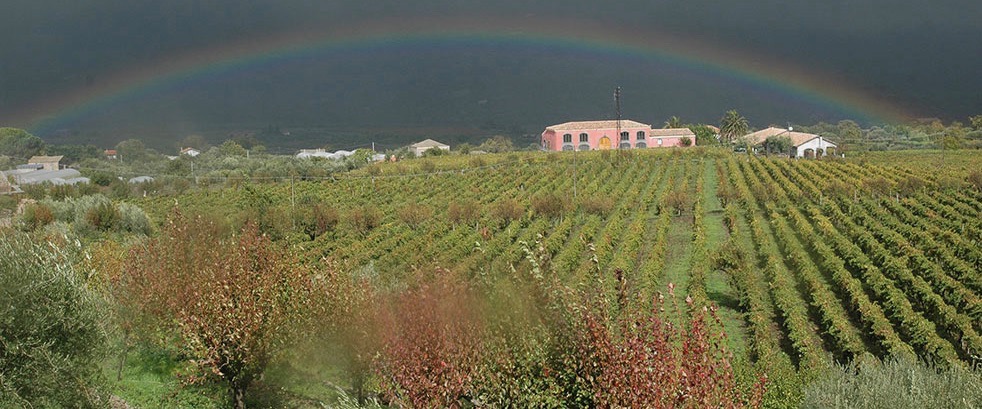
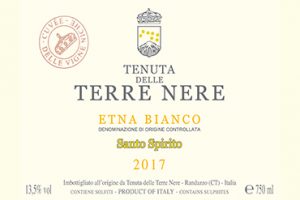
You must be logged in to post a comment.